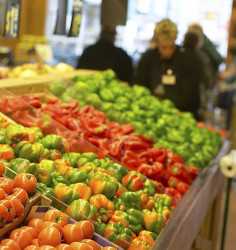5 Consumer Trends Growers Should Know About

As a member of the agriculture industry, it’s important to stay on top of the most recent consumer trends related to your product. Below is a list of five trends that stood out the most in the past year:
1. Local consumption over organic: Within the last couple years, the trend to buy fruits and vegetables at the local level vs. purchasing organic has taken off; so much so that recent studies conducted by the Produce Marketing Association (PMA) show that 69% of consumers valued locally produced fruits and vegetables and saw it as a “desirable trait,” compared with only 29% of consumers that saw organically produced fruits and veggies as favorable. Overall, 72% of consumers expressed that they frequent restaurants that serve local foods, and the trend is due in good part to consumers’ interest in investing more into their local economies.
75% of consumers were cited as purchasing organic products for consumption in their homes, and over the last several years they’ve become even more selective with their “non-conventional” food purchases. For example, the study showed that consumers are willing to pay up to 33% more for organic milk, but only 15% more for products labeled natural.
On a different note, more and more frequently, land that was formerly occupied by abandoned buildings is being converted into spaces to farm fresh, locally grown produce. This type of farming has changed the consumer dynamic as it relates to their food purchases. Furthermore, it’s becoming a viable way to manage urban poverty by increasing lower income residents’ access to quality food.
Scan the pages below for the rest of the lineup.
2. Consumption Of “In-Season” Produce

The trend of eating locally goes hand in hand with the trend of consuming produce in season. This type of consumption means that the buyer purchases a fresh product with the hopes of that product being higher quality and having better taste. When restaurants incorporate locally produced fruits and vegetables in their menus, the consumer gets an idea of what’s available during that season, and how to prepare the food at home.
This trend has the potential of being a lucrative opportunity for exporters depending on the success their particular fruit or vegetable has had at the local and seasonal level. This is to say that exporters could still prepare to export their product when it’s out of season if consumers have shown a strong enough demand for it. An example of this would be avocados, which were initially introduced as a seasonal crop to the U.S. market, but because of an increased demand, were being imported year round from a variety of different countries, primarily from Mexico.
3. Hyper-Local Production

The trend of local consumption has inspired several restaurants to start up their own fruit or vegetable gardens, and as a marketing tool (and as a matter of convenience) some chefs advertise dishes as having been created with “ingredients gathered freshly this morning from the garden.” This new trend has yet to be adopted by all restaurants for several reasons, and requires additional up front investments from the restaurant owner which are reflected in the price of the dishes. Many of the owners of these restaurants are self-sufficient, and whether they get their food from the back patio of their business or from local operations, the obligation to follow good agricultural practices becomes personal. This trend in particular doesn’t appear to be a threat to larger-scale producers and exporters given that the volume of production and the use of these products is at a much smaller scale.
4. “Flexitarians”

This term refers to a group of consumers that have flexible vegetarian eating habits. This group comprises 30% to 40% of consumers, which added to the vegetarian population represent 43% of consumers that shop in supermarkets. These consumers tend to buy meat in lesser quantities and prefer larger portions of fruits and vegetables.
Due to an increase in consumption of ethnic foods and an increased diversification of preparation methods of fruits and vegetables, this set of consumers is important for producers and exporters who are interested in diversifying their offering. It’s hoped that this group’s influence (not necessarily classified by race, ethnicity, income, or education) will impact the agricultural sector positively by increasing consumption.
5. Nutritional Benefits

Whether it’s because of the countless documentaries about the effects that processed food has on the human body, or the increase of obesity and other food-related illnesses in children and adults (for the first time in American history we’ve seen the first generation with a lower life expectancy than their parents), consumers now more than ever have a heightened awareness of what types of food they’re consuming, and how that food will affect their overall health and well being.
This trend is so apparent that there’s even been a wider variety of healthy options in the frozen food section with food that’s primarily made up of fruits and vegetables and is low in calories. This trend goes hand in hand with the trend of consuming “super fruits” and “super vegetables,” which are simply fruits and vegetables packed with an impressive number of nutrients compared to others. Here, there is another opportunity for producers and exporters to diversify their offering and to provide information to distributors and buyers about the nutritional value of their products. For example, it’s safe to say that most consumers aren’t aware that 100 grams of zucchini provides 67% of the vitamin A they’ll need to meet their daily goal. This is to say that an increased consumption of fresh fruits and vegetables leads to better nutrition and a lessened dependence on supplemental nutrition in the form of chemically produced vitamin supplements.
Sources: PMA, National Restaurant Association: “2012 Restaurant Industry Forecast”










